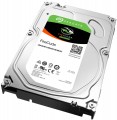Type
The type to which the drive belongs. Hard drives in a broad sense again include several types of drives:
— HDD. Hard drives in the classical sense of the word are drives that record information on rotating magnetic platters. Despite the emergence of more advanced types of drives, classic HDDs still do not lose popularity due to the combination of impressive volumes and low cost. Their main disadvantages are significant weight and power consumption, as well as relatively low speed of reading and writing data.
—
SSHD. Hybrid drives that combine the HDD described above and an SSD solid-state drive in one case; while the system perceives SSHD as a single device. The idea of such a combination is to increase the speed of reading and writing, while retaining the main advantage of the HDD — large volumes at a low cost. To do this, the solid state part of the SSHD acts as a high-speed clipboard between the system and the HDD; in terms of speed, such systems, although they do not reach full-fledged SSDs, are noticeably superior to traditional hard drives.
—
RAID array. RAID arrays implemented as separate devices (usually external, see "Execution"). Such a device consists of several hard drives installed in one housing and combined into an array, perceived by the system as a single drive. There are several types (levels) of RAID, which differ in the way disks interact in an array and
..., accordingly, in the specifics of their application. So, in RAID 0, information is alternately written to each disk, which increases the speed of work; in RAID 1, each disk is a copy of all the others, which gives maximum fault tolerance, etc. Detailed information on RAID levels can be found in special sources. Also note here that buying a RAID array may turn out to be more convenient than assembling it from separately purchased disks: a ready-made array is initially equipped with everything you need and requires only minimal configuration. The main thing is to clarify before buying which RAID levels the selected model supports.Manufacturer's warranty
Manufacturer's warranty provided for this model.
In fact, this is the minimum service life promised by the manufacturer, subject to the rules of operation. Most often, the actual service life of the device is much longer than the guaranteed one.
NAND flash memory
The amount of NAND solid-state memory installed in the SSHD (see "Drive Type").
Such memory acts as a high-speed buffer between the system and the hard drive itself. Usually, the most frequently called data is stored in it, which speeds up subsequent access to them; and when writing data to a disk, this data is first stored in a buffer before being transferred to disk platters. Most modern SSHD drives carry 8 GB of solid-state memory on board — this is considered the most reasonable compromise between speed and overall cost of the device.
Data transfer rate
The speed of data transfer between the disk and client devices is determined by the type of drive, spindle speed, memory buffer size and connection connectors. The last parameter is the most important, since it is impossible to exceed the bandwidth of a particular interface.
Operation power consumption
The amount of power consumed by the disk when reading and writing information. In fact, this is the peak power consumption, it is in these modes that the drive consumes the most energy.
HDD power consumption data is needed primarily to calculate the overall system power consumption and power supply requirements for the system. In addition, for laptops that are planned to be used often "in isolation from outlets", it is advisable to choose more economical drives.
Standby power consumption
The amount of power consumed by the disk "idle". In the on state, the disk platters rotate regardless of whether information is being written or read or not — maintaining this rotation takes the energy consumed while waiting.
The lower the power consumption while waiting, the more economical the disk is, the less energy it consumes. At the same time, we note that in fact this parameter is relevant mainly when choosing a drive for a laptop, when energy efficiency is crucial. For stationary PCs, “idle” power consumption does not play a special role, and when calculating the requirements for a power supply, it is necessary to take into account not this indicator, but the power consumption during operation (see above).

